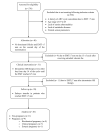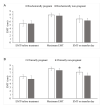Growth Hormone: A Potential Treatment of Patients with Refractory Thin Endometrium: A Clinical Trial Study
- PMID: 36273309
- PMCID: PMC9627013
- DOI: 10.22074/ijfs.2022.541389.1210
Growth Hormone: A Potential Treatment of Patients with Refractory Thin Endometrium: A Clinical Trial Study
Abstract
Background: Growth hormone (GH) is a potential treatment in the assisted reproductive technology (ART) to improve endometrial receptivity and thickness. In the current study, we investigated the effect of the intrauterine administration of GH on the endometrial thickness (EMT) and ART outcomes in the patients with refractory thin endometrium.
Materials and methods: In this clinical trial study, women with a refractory thin endometrium and a history of one or more frozen embryo transfer (FET) cancellation who were referred to the infertility center of the Tabriz Al-Zahra hospital (Tabriz, Iran) and Milad Infertility Clinic (Tabriz, Iran) received intrauterine injections of GH every other day from day 14 of the menstrual cycle until the EMT reached ≥7 mm in addition to the routine endometrium preparation protocol. EMT was evaluated during the treatment and in the cases with EMT ≥7 mm, biochemical/clinical pregnancy was evaluated after embryo transfer.
Results: Thirty-one women aged 35.29 ± 6.21 years were included in this study. The mean amount of EMT was significantly increased following the GH treatment (7.03 ± 1.23 mm) vs. before treatment (5.14 ± 1.1 mm, P<0.001). The EMT reached ≥7 mm in the 65% patients (20/31). Also, the embryo transfer resulted in pregnancy in the patients, biochemical pregnancy: 9/20 (45%) and clinical pregnancy: 7/20 (35%). There was a positive correlation between EMT on the day 13 of cycle (before the treatment) and the maximum EMT (r=0.577 and P=0.001). The EMT was statistically different on the embryo transfer day between clinically pregnant and non-pregnant women (7.18 ± 0.56 vs. 6.21 ± 0.72 mm, P=0.007).
Conclusion: The intrauterine administration of GH could be an appropriate therapeutic strategy for patients with refractory thin endometrium. This treatment could significantly increase the EMT as well as implantation and pregnancy rates in these patients (registration number: IRCT20210220050429N1).
Keywords: Growth hormone; Pregnancy; Thin Endometrium; art; implantation.
Figures


Similar articles
-
Angiogenic factor-driven improvement of refractory thin endometrium with autologous platelet-rich plasma intrauterine infusion in frozen embryo transfer cycles.Front Endocrinol (Lausanne). 2024 Sep 3;15:1431453. doi: 10.3389/fendo.2024.1431453. eCollection 2024. Front Endocrinol (Lausanne). 2024. PMID: 39290323 Free PMC article.
-
Effect of Autologous Platelet-Rich Plasma Treatment on Refractory Thin Endometrium During the Frozen Embryo Transfer Cycle: A Pilot Study.Front Endocrinol (Lausanne). 2019 Feb 14;10:61. doi: 10.3389/fendo.2019.00061. eCollection 2019. Front Endocrinol (Lausanne). 2019. PMID: 30837945 Free PMC article.
-
Autologous platelet-rich plasma optimizes endometrial thickness and pregnancy outcomes in women with refractory thin endometrium of varied aetiology during fresh and frozen-thawed embryo transfer cycles.JBRA Assist Reprod. 2022 Jan 17;26(1):13-21. doi: 10.5935/1518-0557.20210037. JBRA Assist Reprod. 2022. PMID: 34296832 Free PMC article.
-
Administration of growth hormone improves endometrial function in women undergoing in vitro fertilization: a systematic review and meta-analysis.Hum Reprod Update. 2022 Nov 2;28(6):838-857. doi: 10.1093/humupd/dmac028. Hum Reprod Update. 2022. PMID: 35641113
-
Endometrial preparation for women undergoing embryo transfer with frozen embryos or embryos derived from donor oocytes.Cochrane Database Syst Rev. 2020 Oct 28;10(10):CD006359. doi: 10.1002/14651858.CD006359.pub3. Cochrane Database Syst Rev. 2020. PMID: 33112418 Free PMC article.
Cited by
-
New advances in the treatment of thin endometrium.Front Endocrinol (Lausanne). 2024 Apr 30;15:1269382. doi: 10.3389/fendo.2024.1269382. eCollection 2024. Front Endocrinol (Lausanne). 2024. PMID: 38745960 Free PMC article.
-
The Effect of Intrauterine Administration of Growth Hormone on IVF Success Rate in Recurrent Implantation Failure Women: A Randomized Clinical Trial.Iran J Pharm Res. 2024 Dec 16;23(1):e153636. doi: 10.5812/ijpr-153636. eCollection 2024 Jan-Dec. Iran J Pharm Res. 2024. PMID: 40066111 Free PMC article.
-
Fibroblast growth factor 1 ameliorates thin endometrium in rats through activation of the autophagic pathway.Front Pharmacol. 2023 Apr 20;14:1143096. doi: 10.3389/fphar.2023.1143096. eCollection 2023. Front Pharmacol. 2023. PMID: 37153783 Free PMC article.
References
-
- Toner JP, Coddington CC, Doody K, Van Voorhis B, Seifer DB, Ball GD, et al. Society for assisted reproductive technology and assisted reproductive technology in the United States: a 2016 update. Fertil Steril. 2016;106(3):541–546. - PubMed
-
- Cimadomo D, Soscia D, Vaiarelli A, Maggiulli R, Capalbo A, Ubaldi FM, et al. Looking past the appearance: a comprehensive description of the clinical contribution of poor-quality blastocysts to increase live birth rates during cycles with aneuploidy testing. Hum Reprod. 2019;34(7):1206–1214. - PubMed
-
- Munné S, Kaplan B, Frattarelli JL, Child T, Nakhuda G, Shamma FN, et al. Preimplantation genetic testing for aneuploidy versus morphology as selection criteria for single frozen-thawed embryo transfer in good-prognosis patients: a multicenter randomized clinical trial. Fertil Steril. 2019;112(6):1071–1079. - PubMed
-
- Eftekhar M, Tabibnejad N, Tabatabaie AA. The thin endometrium in assisted reproductive technology: an ongoing challenge. Middle East Fertil Soc J. 2018;23(1):1–7.
Publication types
LinkOut - more resources
Full Text Sources
Medical
